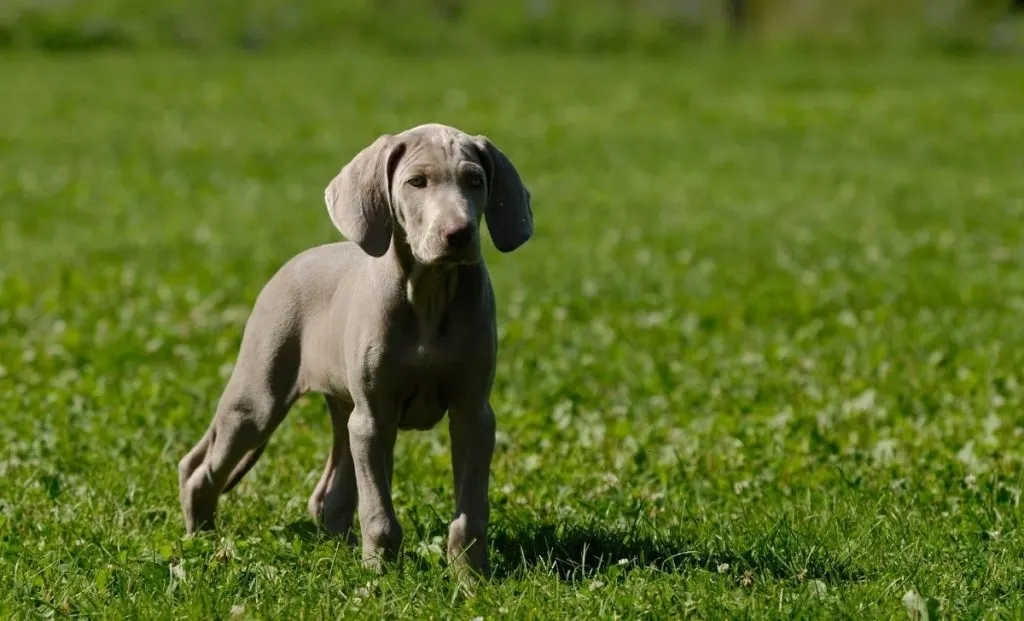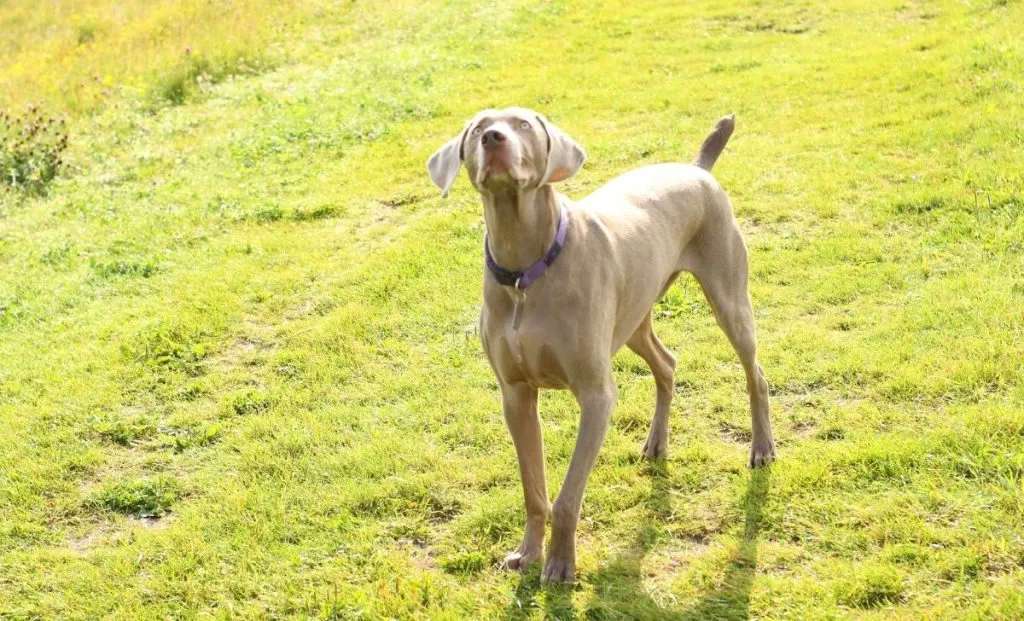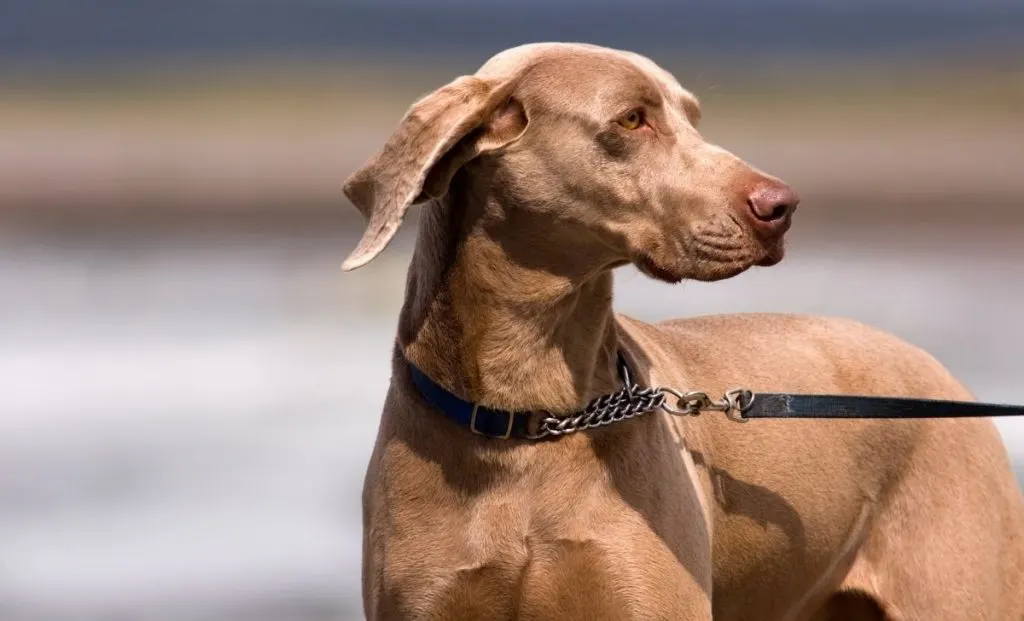Are you looking to buy a new hunting dog and are considering getting a Weimaraner puppy? A Weimaraner growth chart is one of the handiest tools you can get!
Also known as a Gray Ghost, this dog breed is still quite mysterious as it isn’t as popular as some other canines. There are a lot of questions aspiring owners might have about these obedient hunting dogs, and some of them are regarding the dog’s size.
So, just how big do these dogs actually get?
The following chart will give you a better insight into a Weimaraner growth chart, all the growth stages your dog will go through, and what changes you can expect month by month.
Let’s get started!
Weimaraner Growth Chart
| Weight | Height | |
| 1 Month | 5 – 7 lbs | 2.5 – 2.8 inches |
| 2 Months | 13 – 16 lbs | 6 – 8 inches |
| 3 Months | 27 – 31 lbs | 12.5 – 14 inches |
| 6 Months | 52 – 65 lbs | 21 – 23 inches |
| 8 Months | 62 – 78 lbs | 22 – 25 inches |
| 12 Months | 69 – 87 lbs | 23 – 26 inches |
| 18 Months | 70 – 90 lbs | 23 – 27 inches |
Weimaraner Growth Stages

Weimaraners are large dogs with floppy ears and long legs. They are well-known for their gorgeous blue colors, which has earned them the Gray Ghost nickname.
Their official standard states males can reach 27 inches in height, while females are somewhat shorter, typically reaching only 23-24 inches. The average weight is between 70 and 90 lbs.
Due to their size, they might require some different care than other, smaller breeds, which is one of the reasons why understanding the Weimaraner growth chart is so important.
However, even this care greatly depends on the current development stage your Weimaraner has reached.
For example, you cannot expect to provide a puppy in the traditional period with the same type of care as an adult canine!
It’s important to note, however, that every pup is an individual dog that might deter a bit from typical growth patterns.
Still, this is what you can expect from your Weimaraner dog:
Neonatal Stage (0 – 2 Weeks)
During the first two weeks of their lives, Weimaraners are entirely reliant on their mother. Other large dogs, such as Great Danes, will also go through this phase at this time.
The weights and heights of Weimaraner puppies should vary that much at birth, and if you see a dog that is significantly smaller than the others, take him to the vet, just in case he is a runt of the litter.
Don’t expect to see active or playful puppies at this time. These doggies spend most of their time nursing and sleeping.
Also, the entire family should be monitored during this time. While rare, some dogs might eat their puppies, and you don’t want to allow this to happen!
Transitional Period (2 – 4 Weeks)

Weimaraner puppies become a bit more active and curious around this time. While they’ll always stay a short walk from their mothers, they will try to discover new things on their own – although still shyly.
They’ll still fully depend on their mothers, but they’ll start interacting with each other and maybe even with their owner.
It’s a good idea to slowly start handling these pups. Just remember to stay gentle, as they’re very fragile.
Socialization Stage (4 – 12 Weeks)
This is the time when your Weimaraners finally become social and active!
They’ll start exploring the world around them and straying away from their mother, although they’ll still come back to her to nurse.
Even this should quickly come to an end, however, as by the time they are 4-5 weeks old, it’s time to start weaning them off the mother’s milk and find some good puppy food packaging that will give them all the necessary nutrients they now need.
Expect some diarrhea and vomiting at this time, as their tummies are still not used to solid foods. While this is normal, contact your vet if you notice your pooch losing weight.
This is also the time when you should start training and socializing your Weim pup. However, keep in mind that they still don’t have the ability to stay focused for long, and they get tired very easily.
Still, the best timing is now, although don’t worry – it’s never too late to start.
Juvenile Stage (3 – 6 Months)

This is the time when your Weimaraners will experience a huge growth spurt. They’ll become independent from their mothers and start doing everything on their own!
As their puppy teeth are still growing and their tummies are still getting used to the solid food, they should still stick to the same food you’ve been giving them.
Also, this is a time when you can start taking them on walks – provided that you’ve vaccinated them on time.
Just remember that they shouldn’t get too much exercise, as this can result in some bone and joint issues.
If you haven’t by now, you should dedicate a large portion of your time to dog training. The best way to train them is with positive reinforcement, as this will always have good results.
Never yell or punish your Weimaraner puppy. Although this might not look to be the case, they are sensitive pups that will shut down if you are too rough. It’s always better to reward good behaviors than to punish the bad ones.
Adolescent Stage (6 – 12 Months)
At this time, your puppy will get the general appearance of an adult, only smaller. His growth rate will gradually slow down, although he still has lots of growing to do.
A proper diet is of utmost importance to ensure your pooch is growing properly. However, by this time, his dietary needs have changed, so it’s time to change the type of food you’re giving him.
Switching to adult food should be a gradual process, and this is yet another time when an upset tummy is expected.
The best way to make this transition as painless as possible is to mix a little bit of adult food into his standard puppy food. Increase the amount as time passes until your puppy’s diet consists entirely of adult dog food.
While by this time, he still won’t reach his adult weight and height, he’ll get quite close to it, especially in terms of height.
Another fun trait is that their lighter coat will slowly switch to the darker one, but it still won’t be as deep blue as in adults.
Most dogs will reach sexual maturity before their first birthday, so it’s time to start considering spaying and neutering. Contact your vet about when is the right time for this procedure.
Adulthood (1 Year And Older)

Once your Weimaraner turns one, he can finally be considered an adult. He’ll quickly reach his full height, as well as get his final color, which this breed is well-known for.
While they aren’t likely to become any taller, many Weimaraners will still experience some fluctuations in weight as they gain more muscle mass.
These graceful adults can still become quite heavy, and they are prone to obesity, so a balanced diet combined with regular exercise is crucial for keeping them as healthy as possible.
Senior Years (7 Years And Older)
While your Weimaraner is technically still considered an adult once he is older, some things do change.
For example, his nutritional needs will change, and an ideal diet will consist of many animal proteins, vitamins, and minerals. This is the time to switch to senior dog food that will suit him better.
Your old Weim might also become less active and lose some muscle mass. Minor weight loss is completely normal at this age, so don’t panic if you notice he is slightly slimmer.
Of course, contact your vet if you notice any large changes in your dog. It is your duty to provide your beloved pet with as much comfort and support as possible at this age.
When Do Weimaraners Stop Growing?

While there are some general guidelines to when a dog stops growing, this depends on the individual dog and many factors that should be considered. A Weimaraner growth chart can also be helpful, although it shouldn’t be taken too literally.
The main factor that determines your dog’s growth rate is genetics. However, a few other things can also affect this, such as diet, exercise, and even some health problems.
Still, most Weimaraners are expected to reach their adult size around their first birthday. They can reach a full height even sooner, around 7-8 months of age.
Reaching their full weight, however, can take up to two years.
How Big Will My Weimaraner Get?

Even with all the Weimaraner growth charts in the world, it’s impossible to fully predict just how big your Weimaraner will be.
Most healthy adults can easily reach the size of a smaller child, but some are a bit larger or smaller than that.
While some people like to look at the dog’s paws, as it’s said that a puppy will always grow into them, the only way to predict just how big your pup will be is to conduct DNA testing.
Most vet offices will do this service, and this can give you a good insight into not only your dog’s size, but also his health background.
Of course, you can always look into your dog’s parents and suppose your Weim will be approximately that size. However, there is always a danger of some hidden recessive genes that can surprise you.
No matter their size, Weimaraners are excellent family pets everyone will love. Hopefully this height and weight chart will also allow you to properly prepare for your pup’s growing up!

Vanja’s passion for writing started at an early age, which is why she pursued Journalism as her college degree. She can research any topic and find all the information before you bat an eye, which is a great thing for her job but a terrible one for her husband.
Even as a young child, she fell in love with everything fluffy – but dogs have a special place in her heart due to her childhood companion, a Corgie named Archie.
Motivated by her experiences and driven by a desire to give back to her four-legged companions, she spends her free time volunteering at a local dog shelter.
